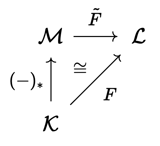I shall sketch out a proof that $\mathbf{Prof}$ is almost obtained from $\mathbf{Cat}$ by adjoining right adjoints to every 1-cell, following Roald Koudenburg's suggestions in the comments. The remaining question is which isomorphisms of 1-cells hold in $\mathbf{Prof}$ that do not hold for purely formal reasons.
Edit: the following is not quite true, because there may be additional isomorphisms between 2-cells of $\mathcal M$ that do not hold for purely formal reasons, e.g. Beck–Chevalley conditions.
Proposition. Let $({-})_* \colon \mathcal K \to \mathcal M$ be a proarrow equipment in which every 1-cell $P \colon X \not\to Y$ in $\mathcal M$ factors (not necessarily uniquely) as a representable followed by a corepresentable, and as a corepresentable followed by a representable, i.e. $P \cong {p_1}_* ; {p_2}^*$ and $P \cong {p_3}^* ; {p_4}_*$ for $p_1, p_2, p_3, p_4$ in $\mathcal K$. Then $({-})_*$ exhibits $\mathcal M$ as the free adjunction of right adjoints to 1-cells in $\mathcal K$, in the sense that, for any pseudofunctor $F \colon \mathcal K \to \mathcal L$ for which each 1-cell in the image of $F$ has a right adjoint, there is an essentially unique pseudofunctor $\tilde F \colon \mathcal M \to \mathcal L$ making the following diagram commute up to pseudonatural isomorphism. (Note that $\tilde F$, being a pseudofunctor, necessarily preserves adjunctions.)
Proof. We shall show that any pseudofunctor $L \colon \mathcal M \to \mathcal L$ is determined by its action on representables, by which the result will follow. Since $({-})_*$ is the identity-on-objects, the action of $L$ on 0-cells is trivially determined by the action on representable 0-cells, since every 0-cell is representable. For any proarrow $P$, we have $L(P) \cong L({p_1}_* ; {p_2}^*) \cong L({p_1}_*) ; L({p_2}^*)$, hence determined by the action of $L$ on representables and corepresentables. But the action on corepresentables is determined by the action on representables, since we must have $L({p_2}^*) \cong L({p_2}_*)^*$ since ${p_2}_* \dashv {p_2}^*$ and pseudofunctors preserve adjunctions. Finally, the action of $L$ on any 2-cell $\phi \colon P \Rightarrow Q$ is determined by its action on $\phi' \colon {p_1}_* ; {p_2}^* \cong P \Rightarrow Q \cong {q_3}^* ; {q_4}_*$. By taking mates, $L(\phi')$ is uniquely determined by its action on a 2-cell ${q_3}^* ; {p_1}_* \Rightarrow {q_4}_* ; {p_2}_*$ which is necessarily representable as $({-})_*$ is locally fully faithful.
Therefore, $L$ is determined on 0-cells, 1-cells, and 2-cells by its action on representables, and hence by the pseudofunctor $L({-})_* \colon \mathcal K \to \mathcal M$. Given a pseudofunctor $F \colon \mathcal K \to \mathcal L$, there is thus an essentially unique pseudofunctor $\tilde F \colon \mathcal M \to \mathcal L$ making the diagram commute up to pseudonatural isomorphism.
The desired characterisation of $\mathbf{Prof}$ now follows.
Corollary. The proarrow equipment $({-})_* \colon \mathbf{Cat} \to \mathbf{Prof}$ exhibits $\mathbf{Prof}$ as the free adjunction of right adjoints to 1-cells in $\mathbf{Cat}$.
Proof. Every profunctor factors as a representable followed by a corepresentable using the collage construction, and as a corepresentable followed by a representable using the cocollage construction (Proposition 2.3.2 in Les distributeurs). The result then follows by applying the Proposition.


